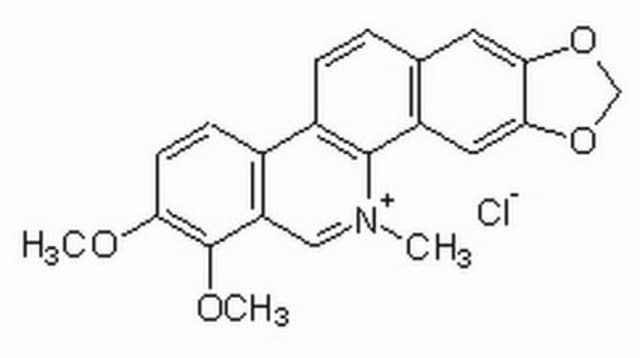SMB00314
Coptisine Chloride
≥98% (HPLC)
Sinónimos:
Coptisine chloride, Bis(methylenedioxy)protoberberine chloride, Coptisin Chloride
Seleccione un Tamaño
449,00 €
Seleccione un Tamaño
About This Item
449,00 €
Productos recomendados
Ensayo
≥98% (HPLC)
Formulario
powder
aplicaciones
metabolomics
vitamins, nutraceuticals, and natural products
temp. de almacenamiento
−20°C
cadena SMILES
C1(OCO2)=C2C=C(CC[N+]3=C4C=C5C(C(OCO6)=C6C=C5)=C3)C4=C1.[Cl-]
InChI
1S/C19H14NO4.ClH/c1-2-16-19(24-10-21-16)14-8-20-4-3-12-6-17-18(23-9-22-17)7-13(12)15(20)5-11(1)14;/h1-2,5-8H,3-4,9-10H2;1H/q+1;/p-1
Clave InChI
LUXPUVKJHVUJAV-UHFFFAOYSA-M
Categorías relacionadas
Descripción general
Aplicación
Acciones bioquímicas o fisiológicas
Palabra de señalización
Danger
Frases de peligro
Consejos de prudencia
Clasificaciones de peligro
Acute Tox. 2 Inhalation - Acute Tox. 2 Oral
Código de clase de almacenamiento
6.1A - Combustible acute toxic Cat. 1 and 2 / very toxic hazardous materials
Clase de riesgo para el agua (WGK)
WGK 3
Punto de inflamabilidad (°F)
Not applicable
Punto de inflamabilidad (°C)
Not applicable
Elija entre una de las versiones más recientes:
Certificados de análisis (COA)
¿No ve la versión correcta?
Si necesita una versión concreta, puede buscar un certificado específico por el número de lote.
¿Ya tiene este producto?
Encuentre la documentación para los productos que ha comprado recientemente en la Biblioteca de documentos.
Los clientes también vieron
Filtros activos
Nuestro equipo de científicos tiene experiencia en todas las áreas de investigación: Ciencias de la vida, Ciencia de los materiales, Síntesis química, Cromatografía, Analítica y muchas otras.
Póngase en contacto con el Servicio técnico











